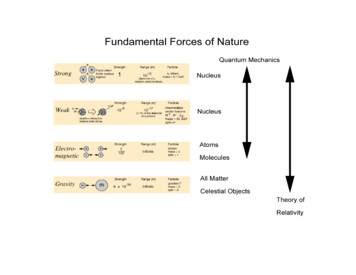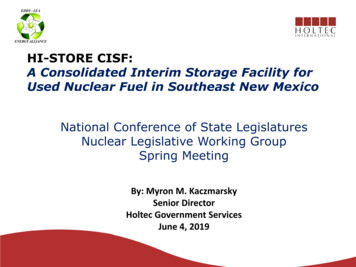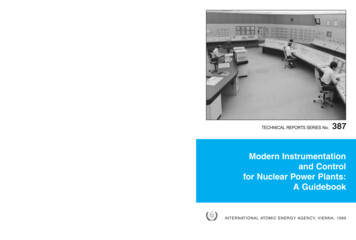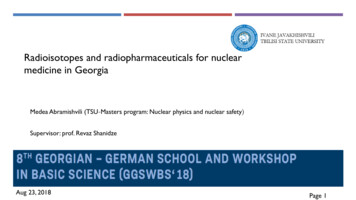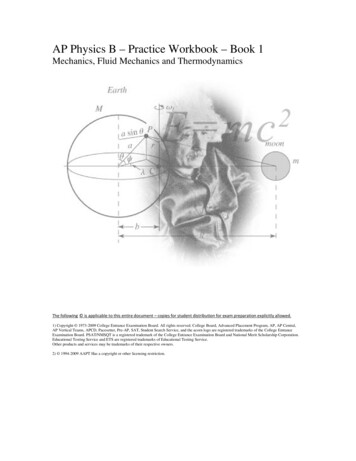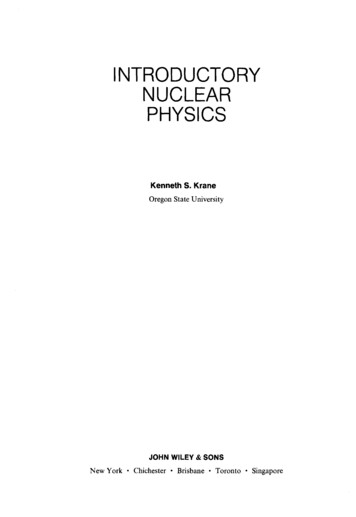
Transcription
INTRODUCTORYNUCLEARPHYSICSKenneth S. KraneOregon State UniversityJOHN WlLEY & SONSNew YorkChichesterBrisbaneTorontoSingapore
Copyright 0 1988, by John Wiley & Sons, Inc.All rights reserved. Published simultaneously in Canada.Reproduction or translation of any part ofthis work beyond that permitted by Sections107 and 108 of the 1976 United States CopyrightAct without the permission of the copyrightowner is unlawful. Requests for permissionor further information should be addressed tothe Permissions Department, John Wiley & Sons.Library of Congress Cataloging in Publication Data:Krane, Kenneth S.Introductory nuclear physics.Rev. ed. of Introductory nuclear physics/David Halliday. 2nd. ed. 1955.1. Nuclear physics. I. Halliday, David, 1916 Introductory nuclear physics. 11. Title.QC777.K73 1987539.787-10623ISBN 0-471-80553-XPrinted in the United States of America10 9 8 7 6 5 4 3 2
PREFACEThis work began as a collaborative attempt with David Halliday to revise andupdate the second edition of his classic text Introductory Nuclear Physics (NewYork: Wiley, 1955). As the project evolved, it became clear that, owing to othercommitments, Professor Halliday would be able to devote only limited time tothe project and he therefore volunteered to remove himself from active participation, a proposal to which I reluctantly and regretfully agreed. He was kindenough to sign over to me the rights to use the material from the previous edition.I first encountered Halliday’s text as an undergraduate physics major, and itwas perhaps my first real introduction to nuclear physics. I recall being impressedby its clarity and its readability, and in preparing this new version, I have tried topreserve these elements, which are among the strengths of the previous work.Audience This text is written primarily for an undergraduate audience, butcould be used in introductory graduate surveys of nuclear physics as well. It canbe used specifically for physics majors as part of a survey of modern physics, butcould (with an appropriate selection of material) serve as an introductory coursefor other areas of nuclear science and technology, including nuclear chemistry,nuclear engineering, radiation biology, and nuclear medicine.Background It is expected that students have a previous background in quantum physics, either at the introductory level [such as the author’s text ModernPhysics (New York: Wiley, 1983)] or at a more advanced, but still undergraduatelevel. (A brief summary of the needed quantum background is given in Chapter2.) The text is therefore designed in a “ two-track” mode, so that the material thatrequires the advanced work in quantum mechanics, for instance, transitionprobabilities or matrix elements, can be separated from the rest of the text byskipping those sections that require such a background. This can be done withoutinterrupting the logical flow of the discussion.Mathematical background at the level of differential equations should besufficient for most applications.Emphasis There are two features that distinguish the present book. The first isthe emphasis on breadth. The presentation of a broad selection of materialpermits the instructor to tailor a curriculum to meet the needs of any particularV
viPREFACEstudent audience. The complete text is somewhat short for a full-year course, buttoo long for a course of quarter or semester length. The instructor is thereforeable to select material that will provide students with the broadest possibleintroduction to the field of nuclear physics, consistent with the time available forthe course.The second feature is the unabashedly experimental and phenomenologicalemphasis and orientation of the presentation. The discussions of decay andreaction phenomena are accompanied with examples of experimental studiesfrom the literature. These examples have been carefully selected followingsearches for papers that present data in the clearest possible manner and thatrelate most directly to the matter under discussion. These original experimentsare discussed, often with accompanying diagrams of apparatus, and results withuncertainties are given, all in the attempt to convince students that progress innuclear physics sprang not exclusively from the forehead of Fermi, but insteadhas been painstakingly won in the laboratory. At the same time, the rationale andmotivation for the experiments are discussed, and their contributions to thetheory are emphasized.Organization The book is divided into four units: Basic Nuclear Structure,Nuclear Decay and Radioactivity, Nuclear Reactions, and Extensions and Applications. The first unit presents background material on nuclear sizes and shapes,discusses the two-nucleon problem, and presents an introduction to nuclearmodels. These latter two topics can be skipped without loss of continuity in anabbreviated course. The second unit on decay and radioactivity presents thetraditional topics, with new material included to bring nuclear decay nearly intothe current era (the recently discovered “heavy” decay modes, such as 14C,double P decay, P-delayed nucleon emission, Mossbauer effect, and so on). Thethird unit surveys nuclear reactions, including fission and fusion and theirapplications. The final unit deals with topics that fall only loosely under thenuclear physics classification, including hyperfine interactions, particle physics,nuclear astrophysics, and general applications including nuclear medicine. Theemphasis here is on the overlap with other physics and nonphysics specialties,including atomic physics, high-energy physics, cosmology, chemistry, and medicine. Much of this material, particularly in Chapters 18 and 19, representsaccomplishments of the last couple of years and therefore, as in all such volatileareas, may be outdated before the book is published. Even if this should occur,however, the instructor is presented with a golden opportunity to make importantpoints about progress in science. Chapter 20 features applications involvingsimilarly recent developments, such as PET scans. The material in this last unitbuilds to a considerable degree on the previous material; it would be very unwise,for example, to attempt the material on meson physics or particle physics withouta firm grounding in nuclear reactions.Sequence Chapters or sections that can be omitted without loss of continuity inan abbreviated reading are indicated with asterisks (*) in the table of contents.An introductory short course in nuclear physics could be based on Chapters 1, 2,3, 6, 8, 9, 10, and 11, which cover the fundamental aspects of nuclear decay andreactions, but little of nuclear structure. Fission and fusion can be added from
PREFACEviiChapters 13 and 14. Detectors and accelerators can be included with materialselected from Chapters 7 and 15.The last unit (Chapters 16 to 20) deals with applications and does notnecessarily follow Chapter 15 in sequence. In fact, most of this material could beincorporated at any time after Chapter 11 (Nuclear Reactions). Chapter 16,covering spins and moments, could even be moved into the first unit afterChapter 3. Chapter 19 (Nuclear Astrophysics) requires background material onfission and fusion from Chapters 13 and 14.Most of the text can be understood with only a minimal background inquantum mechanics. Chapters or sections that require a greater background (butstill at the undergraduate level) are indicated in the table of contents with adagger ("fMany undergraduates, in my experience, struggle with even the most basicaspects of the quantum theory of angular momentum, and more abstract concepts, such as isospin, can present them with serious difficulties. For this reason,the introduction of isospin is delayed until it is absolutely necessary in Chapter11 (Nuclear Reactions) where references to its application to beta and gammadecays are given to show its importance to those cases as well. No attempt ismade to use isospin coupling theory to calculate amplitudes or cross sections. Inan abbreviated coverage, it is therefore possible to omit completely any discussion of isospin, but it absolutely must be included before attempting Chapters 17and 18 on meson and particle physics.Notation Standard notation has been adopted, which unfortunately overworksthe symbol T to represent kinetic energy, temperature, and isospin. The particlephysicist's choice of I for isospin and J for nuclear spin leaves no obviousalternative for the total electronic angular momentum. Therefore, I has beenreserved for the total nuclear angular momentum, J for the total electronicangular momentum, and T for the isospin. To be consistent, the same scheme isextended into the particle physics regime in Chapters 17 and 18, even though itmay be contrary to the generally accepted notation in particle physics. Thelowercase j refers to the total angular momentum of a single nucleon or atomicelectron.References No attempt has been made to produce an historically accurate set ofreferences to original work. This omission is done partly out of my insecurityabout assuming the role of historian of science and partly out of the convictionthat references tend to clutter, rather than illuminate, textbooks that are aimedlargely at undergraduates. Historical discussions have been kept to a minimum,although major insights are identified with their sources. The history of nuclearphysics, which so closely accompanies the revolutions wrought in twentieth-century physics by relativity and quantum theory, is a fascinating study in itself, andI encourage serious students to pursue it. In stark contrast to modern works, theclassic papers are surprisingly readable. Many references to these early paperscan be found in Halliday's book or in the collection by Robert T. Beyer,Foundations of Nuclear Physics (New York: Dover, 1949), which contains reprintsof 13 pivotal papers and a classified bibliography of essentially every nuclearphysics publication up to 1947.
viiiPREFACEEach chapter in this textbook is followed with a list of references for furtherreading, where more detailed or extensive treatments can be found. Included inthe lists are review papers as well as popular-level books and articles.Several of the end-of-chapter problems require use of systematic tabulations ofnuclear properties, for which the student should have ready access to the currentedition of the Table of Isotopes or to a complete collection of the Nuclear DataSheets.Acknowledgments Many individuals read chapters or sections of the manuscript.I am grateful for the assistance of the following professional colleagues andfriends: David Arnett, Carroll Bingham, Merle Bunker, H. K. Carter, Charles W.Drake, W. A. Fowler, Roger J. Hanson, Andrew Klein, Elliot J. Krane, Rubin H.Landau, Victor A. Madsen, Harvey Marshak, David K. McDaniels, Frank A.Rickey, Kandula S. R. Sastry, Larry Schecter, E. Brooks Shera, Richard R.Silbar, Paul Simms, Rolf M. Steffen, Gary Steigman, Morton M. Sternheim,Albert W. Stetz, and Ken Toth. They made many wise and valuable suggestions,and I thank them for their efforts. Many of the problems were checked by MiltonSagen and Paula Sonawala. Hundreds of original illustrations were requested ofand generously supplied by nuclear scientists from throughout the world. KathyHaag typed the original manuscript with truly astounding speed and accuracyand in the process helped to keep its preparation on schedule. The staff at JohnWiley & Sons were exceedingly helpful and supportive, including physics editorRobert McConnin, copy editors Virginia Dunn and Deborah Herbert, andproduction supervisor Charlene Cassimire. Finally, without the kind support andencouragement of David Halliday, this work would not have been possible.Corvullis. OregonFehruurv 1987Kenneth S. Krane
CONTENTSUNIT I BASIC NUCLEAR STRUCTUREChapter 1 BASIC CONCEPTS1.11.21.31.4Chapter 2History and OverviewSome Introductory TerminologyNuclear PropertiesUnits and DimensionsELEMENTS OF QUANTUM MECHANICS2.12.22.32.42.52.62.72.82Quantum BehaviorPrinciples of Quantum MechanicsProblems in One DimensionProblems in Three DimensionsQuantum Theory of Angular MomentumParityQuantum StatisticsTransitions Between StatesChapter 3 NUCLEAR PROPERTIES3.1 The Nuclear Radius3.2 Mass and Abundance of Nuclides3.3 Nuclear Binding Energy3.4 Nuclear Angular Momentum and Parity3.5 Nuclear Electromagnetic Moments3.6 Nuclear Excited States*Chapter 4 THE FORCE BETWEEN NUCLEONS4.1 The Deuteronf4.2 Nucleon-Nucleon Scattering4.3 Proton-Proton and Neutron-NeutronInteractions4.4 Properties of the Nuclear Force4.5 The Exchange Force Denotes material that can be omitted without loss of continuity in an abbreviated reading.t Denotes material that requires somewhat greater familiarity with quantum mechanics.ix
CONTENTSX“Chapter 5NUCLEAR MODELS5.1 The Shell Model5.2 Even-Z, Even-N Nuclei and CollectiveStructure5.3 More Realistic Nuclear Models116117134149UNIT II NUCLEAR DECAY AND RADIOACTIVITYChapter 6RADIOACTIVE DECAY6.1t6.26.36.46.56.6*6.7*6.8“Chapter 7The Radioactive Decay LawQuantum Theory of Radiative DecaysProduction and Decay of RadioactivityGrowth of Daughter ActivitiesTypes of DecaysNatural RadioactivityRadioactive DatingUnits for Measuring RadiationDETECTING NUCLEAR RADIATIONSInteractions of Radiation with MatterGas-Fi Iled CountersScintillation DetectorsSemiconductor DetectorsCounting StatisticsEnergy MeasurementsCoincidence Measurements andTime Resolution7.8 Measurement of Nuclear Lifetimes7.9 Other Detector Types7.17.27.37.47.57.67.7Chapter 8 ALPHA DECAY8.18.28.3 8.48.5“8.6Chapter 9Why Alpha Decay OccursBasic Alpha Decay ProcessesAlpha Decay SystematicsTheory of Alpha EmissionAngular Momentum and Parity in AlphaDecayAlpha Decay SpectroscopyBETADECAY9.1 Energy Release in Beta Decayt9.2 Fermi Theory of Beta Decay9.3 The “Classical” Experimental Tests of the FermiTheory9.4 Angular Momentum and Parity SelectionRules9.5 Comparative Half-Lives and 77282289292
CONTENTSxi“9.6*9.7*9.8*9.9*9.10Neutrino PhysicsDouble Beta DecayBeta-Delayed Nucleon EmissionNonconservation of ParityBeta SpectroscopyChapter 10 GAMMA tics of Gamma DecayClassical Electromagnetic RadiationTransition to Quantum MechanicsAngular Momentum and ParitySelection RulesAngular Distribution and PolarizationMeasurementsInternal ConversionLifetimes for Gamma EmissionGamma-Ray SpectroscopyNuclear Resonance Fluorescence and theMossbauer Effect29529830230931 5327327328331333335341348351361UNIT 111 NUCLEAR REACTIONSChapter 11 NUCLEAR .1011.11*11.12*11.13Types of Reactions and Conservation LawsEnergetics of Nuclear ReactionslsospinReaction Cross SectionsExperimental TechniquesCoulomb ScatteringNuclear ScatteringScattering and Reaction Cross SectionsThe Optical ModelCompound-Nucleus ReactionsDirect ReactionsResonance ReactionsHeavy-Ion Reactions*Chapter 12 NEUTRON PHYSICS12.112.212.312.412.512.6Neutron SourcesAbsorption and Moderation of NeutronsNeutron DetectorsNeutron Reactions and Cross SectionsNeutron CaptureInterference and Diffraction with NeutronsChapter 13 NUCLEAR FISSION13.1 Why Nuclei Fission13.2 Characteristics of Fission37837838038839239539640540841 341 641 9424431444445447451456462465478479484
xiiCONTENTS13.3 Energy in Fission*13.4 Fission and Nuclear Structure13.5 Controlled Fission Reactions13.6 Fission Reactors:*l3.7 Radioactive Fission Products*13.8 A Natural Fission Reactor13.9 Fission ExplosivesChapter 14 NUCLEAR FUSION14.114.2*14.314.414.5Basic Fusion ProcessesCharacteristics of FusionSolar FusionControlled Fusion ReactorsThermonuclear Weapons*Chapter 15 ACCELERATORS15.115.215.315.415.5UNIT IVElectrostatic AcceleratorsCyclotron AcceleratorsSynchrotronsLinear AcceleratorsColliding-Beam Accelerators48849350150651 251 6520528529530534538553559563571581588593EXTENSIONS AND APPLICATIONS*Chapter 16 NUCLEAR SPIN AND MOMENTS16.116.216.316.4Nuclear SpinNuclear MomentsHyperfine StructureMeasuring Nuclear Moments*Chapter 17 MESON PHYSICS17.117.217.317.417.517.6Yukawa’s HypothesisProperties of Pi MesonsPion-Nucleon ReactionsMeson ResonancesStrange Mesons and BaryonsCP Violation in K Decay*Chapter 18 PARTICLE PHYSICS18.118.218.318.418.518.618.718.8Particle Interactions and FamiliesSymmetries and Conservation LawsThe Quark ModelColored Quarks and GluonsReactions and Decays in the Quark ModelCharm, Beauty, and TruthQuark DynamicsGrand Unified Theories60260260561 061 965365365667167968669270170171 071 8721725733742746
CONTENTSxiii*Chapter 19 NUCLEAR ASTROPHYSICS75519.1 The Hot Big Bang Cosmology19.2 Particle and Nuclear Interactions in the EarlyUniverse19.3 Primordial Nucleosynthesis19.4 Stellar Nucleosynthesis (A 5 60)19.5 Stellar Nucleosynthesis (A 60)19.6 Nuclear Cosmochronology*Chapter 20APPLICATIONS OF NUCLEAR PHYSICS20.120.220.320.420.5Appendix ATrace Element AnalysisMass Spectrometry with AcceleratorsAlpha-Decay ApplicationsDiagnostic Nuclear MedicineTherapeutic Nuclear MedicineSPECIAL ppendix B CENTER-OF-MASS REFERENCE FRAMEa1aAppendix C TABLE OF NUCLEAR PROPERTIES822Credits834Index835
UNIT IBASICNUCLEARSTRUCTURE
IllBASIC CONCEPTSWhether we date the origin of nuclear physics from Becquerel’s discovery ofradioactivity in 1896 or Rutherford’s hypothesis of the existence of the nucleus in1911, it is clear that experimental and theoretical studies in nuclear physics haveplayed a prominent role in the development of twentieth century physics. As aresult of these studies, a chronology of which is given on the inside of the frontcover of this book, we have today a reasonably good understanding of theproperties of nuclei and of the structure that is responsible for those properties.Furthermore, techniques of nuclear physics have important applications in otherareas, including atomic and solid-state physics. Laboratory experiments in nuclearphysics have been applied to the understanding of an incredible variety ofproblems, from the interactions of quarks (the most fundamental particles ofwhich matter is composed), to the processes that occurred during the earlyevolution of the universe just after the Big Bang. Today physicians use techniqueslearned from nuclear physics experiments to perform diagnosis and therapy inareas deep inside the body without recourse to surgery; but other techniqueslearned from nuclear physics experiments are used to build fearsome weapons ofmass destruction, whose proliferation is a constant threat to our future. No otherfield of science comes readily to mind in which theory encompasses so broad aspectrum, from the most microscopic to the cosmic, nor is there another field inwhich direct applications of basic research contain the potential for the ultimatelimits of good and evil.Nuclear physics lacks a coherent theoretical formulation that would permit usto analyze and interpret all phenomena in a fundamental way; atomic physicshas such a formulation in quantum electrodynamics, which permits calculationsof some observable quantities to more than six significant figures. As a result, wemust discuss nuclear physics in a phenomenological way, using a differentformulation to describe each different type of phenomenon, such as a decay, /3decay, direct reactions, or fission. Within each type, our ability to interpretexperimental results and predict new results is relatively complete, yet themethods and formulation that apply to one phenomenon often are not applicableto another. In place of a single unifying theory there are islands of coherentknowledge in a sea of seemingly uncorrelated observations. Some of the mostfundamental problems of nuclear physics, such as the exact nature of the forces
BASIC CONCEPTS 3that hold the nucleus together, are yet unsolved. In recent years, much progresshas been made toward understanding the basic force between the quarks that arethe ultimate constituents of matter, and indeed attempts have been made atapplying this knowledge to nuclei, but these efforts have thus far not contributedto the clarification of nuclear properties.We therefore adopt in this text the phenomenological approach, discussingeach type of measurement, the theoretical formulation used in its analysis, andthe insight into nuclear structure gained from its interpretation. We begin with asummary of the basic aspects of nuclear theory, and then turn to the experimentsthat contribute to our knowledge of structure, first radioactive decay and thennuclear reactions. Finally, we discuss special topics that contribute to microscopic nuclear structure, the relationship of nuclear physics to other disciplines,and applications to other areas of research and technology.1.l HISTORY AND OVERVIEWThe search for the fundamental nature of matter had its beginnings in thespeculations of the early Greek philosophers; in particular, Democritus in thefourth century B.C. believed that each kind of material could be subdivided intosmaller and smaller bits until one reached the very limit beyond which no furtherdivision was possible. This atom of material, invisible to the naked eye, was toDemocritus the basic constituent particle of matter. For the next 2400 years, thisidea remained only a speculation, until investigators in the early nineteenthcentury applied the methods of experimental science to this problem and fromtheir studies obtained the evidence needed to raise the idea of atomism to thelevel of a full-fledged scientific theory. Today, with our tendency toward thespecialization and compartmentalization of science, we would probably classifythese early scientists (Dalton, Avogadro, Faraday) as chemists. Once the chemistshad elucidated the kinds of atoms, the rules governing their combinations inmatter, and their systematic classification (Mendeleev’s periodic table), it wasonly natural that the next step would be a study of the fundamental properties ofindividual atoms of the various elements, an activity that we would today classifyas atomic physics. These studies led to the discovery in 1896 by Becquerel of theradioactivity of certain species of atoms and to the further identification ofradioactive substances by the Curies in 1898. Rutherford next took up the studyof these radiations and their properties; once he had achieved an understandingof the nature of the radiations, he turned them around and used them as probesof the atoms themselves. In the process he proposed in 1911 the existence of theatomic nucleus, the confirmation of whch (through the painstaking experimentsof Geiger and Marsden) provided a new branch of science, nuclear physics,dedicated to studying matter at its most fundamental level. Investigations intothe properties of the nucleus have continued from Rutherford’s time to thepresent. In the 1940s and 1950s, it was discovered that there was yet another levelof structure even more elementary and fundamental than the nucleus. Studies ofthe particles that contribute to the structure at this level are today carried out inthe realm of elementary particle (or high energy) physics.Thus nuclear physics can be regarded as the descendent of chemistry andatomic physics and in turn the progenitor of particle physics. Although nuclear
4BASIC NUCLEAR STRUCTUREphysics no longer occupies center stage in the search for the ultimate componentsof matter, experiments with nuclei continue to contribute to the understanding ofbasic interactions. Investigation of nuclear properties and the laws governing thestructure of nuclei is an active and productive area of physical research in its ownright, and practical applications, such as smoke detectors, cardiac pacemakers,and medical imaging devices, have become common. Thus nuclear physics has inreality three aspects: probing the fundamental particles and their interactions,classifying and interpreting the properties of nuclei, and providing technologicaladvances that benefit society.1.2SOME INTRODUCTORY TERMINOLOGYA nuclear species is characterized by the total amount of positive charge in thenucleus and by its total number of mass units. The net nuclear charge is equal to Z e , where 2 is the atomic number and e is the magnitude of the electroniccharge. The fundamental positively charged particle in the nucleus is the proton,which is the nucleus of the simplest atom, hydrogen. A nucleus of atomic numberZ therefore contains Z protons, and an electrically neutral atom therefore mustcontain Z negatively charged electrons. Since the mass of the electrons isnegligible compared with the proton mass ( m 2000m,), the electron can oftenbe ignored in discussions of the mass of an atom. The mass number of a nuclearspecies, indicated by the symbol A , is the integer nearest to the ratio between thenuclear mass and the fundamental mass unit, defined so that the proton has amass of nearly one unit. (We will discuss mass units in more detail in Chapter 3.)For nearly all nuclei, A is greater than 2, in most cases by a factor of two ormore. Thus there must be other massive components in the nucleus. Before 1932,it was believed that the nucleus contained A protons, in order to provide theproper mass, along with A - 2 nudear electrons to give a net positive charge ofZ e . However, the presence of electrons within the nucleus is unsatisfactory forseveral reasons:1. The nuclear electrons would need to be bound to the protons by a verystrong force, stronger even than the Coulomb force. Yet no evidence for thisstrong force exists between protons and atomic electrons.2. If we were to confine electrons in a region of space as small as a nucleus(Axm), the uncertainty principle would require that these electronshave a momentum distribution with a range A p h / A x 20 MeV/c.Electrons that are emitted from the nucleus in radioactive p decay haveenergies generally less than 1 MeV; never do we see decay electrons with20 MeV energies. Thus the existence of 20 MeV electrons in the nucleus isnot confirmed by observation.3. The total intrinsic angular momentum (spin) of nuclei for which A - 2 isodd would disagree with observed values if A protons and A - 2 electronswere present in the nucleus. Consider the nucleus of deuterium ( A 2,2 l),which according to the proton-electron hypothesis would contain 2protons and 1 electron. The proton and electron each have intrinsic angularmomentum (spin) of , and the quantum mechanical rules for adding spinsof particles would require that these three spins of combine to a total ofeither or . Yet the observed spin of the deuterium nucleus is 1.--
BASIC CONCEPTS 54.Nuclei containing unpaired electrons would be expected to have magneticdipole moments far greater than those observed. If a single electron werepresent in a deuterium nucleus, for example, we would expect the nucleus tohave a magnetic dipole moment about the same size as that of an electron,but the observed magnetic moment of the deuterium nucleus is about & ofthe electron’s magnetic moment.Of course it is possible to invent all sorts of ad hoc reasons for the abovearguments to be wrong, but the necessity for doing so was eliminated in 1932when the neutron was discovered by Chadwick. The neutron is electrically neutraland has a mass about equal to the proton mass (actually about 0.1% larger). Thusa nucleus with 2 protons and A - 2 neutrons has the proper total mass andcharge, without the need to introduce nuclear electrons. When we wish toindicate a specific nuclear species, or nuclide, we generally use the form X N ,where X is the chemical symbol and N is the neutron number, A - 2. Thesymbols for some nuclides are iHo,2;;U,,,, i2Fe30. The chemical symbol and theatomic number 2 are redundant-every H nucleus has 2 1, every U nucleushas 2 92, and so on. It is therefore not necessary to write 2. It is also notnecessary to write N , since we can always find it from A - 2. Thus 238Uis aperfectly valid way to indicate that particular nuclide; a glance at the periodictable tells us that U has 2 92, and therefore 238Uhas 238 - 92 146neutrons. You may find the symbols for nuclides written sometimes with 2 andN , and sometimes without them. When we are trying to balance 2 and N in adecay or reaction process, it is convenient to have them written down; at othertimes it is cumbersome and unnecessary to write them.Neutrons and protons are the two members of the family of nucleons. When wewish simply to discuss nuclear particles without reference to whether they areprotons or neutrons, we use the term nucleons. Thus a nucleus of mass number Acontains A nucleons.When we analyze samples of many naturally occurring elements, we find thatnuclides with a given atomic number can have several different mass numbers;that is, a nuclide with 2 protons can have a variety of different neutron numbers.Nuclides with the same proton number but different neutron numbers are calledisotopes; for example, the element chlorine has two isotopes that are stableagainst radioactive decay, 35Cland 37Cl.It also has many other unstable isotopesthat are artificially produced in nuclear reactions; these are the radioactiveisotopes (or radioisotopes) of C1.It is often convenient to refer to a sequence of nuclides with the same N butdifferent 2; these are called isotones. The stable isotones with N 1 are 2H and3He. Nuclides with the same mass number A are known as isobars; thus stable3He and radioactive 3H are isobars.Once we have identified a nuclide, we can then set about to measure itsproperties, among which (to be discussed later in this text) are mass, radius,relative abundance (for stable nuclides), decay modes and half-lives (for radioactive nuclides), reaction modes and cross sections, spin, magnetic dipole andelectric quadrupole moments, and excited states. Thus far we have ide
tum physics, either at the introductory level [such as the author’s text Modern Physics (New York: Wiley, 1983)] or at a more advanced, but still undergraduate level. (A brief summary of the needed quantum background is given in Chapter 2.) The text is therefore d
